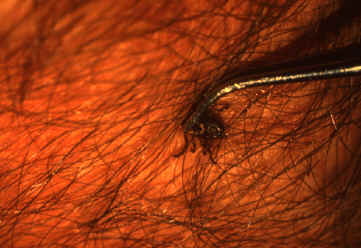Rocky Mountain spotted fever medical therapy
|
Rocky Mountain spotted fever Microchapters |
|
Differentiating Rocky Mountain spotted fever from other Diseases |
|---|
|
Diagnosis |
|
Treatment |
|
Case Studies |
|
Rocky Mountain spotted fever medical therapy On the Web |
|
American Roentgen Ray Society Images of Rocky Mountain spotted fever medical therapy |
|
Directions to Hospitals Treating Rocky Mountain spotted fever |
|
Risk calculators and risk factors for Rocky Mountain spotted fever medical therapy |
Editor-In-Chief: C. Michael Gibson, M.S., M.D. [1]Associate Editor(s)-in-Chief: Sujit Routray, M.D. [2]
Overview
The mainstay of therapy for rocky mountain spotted fever is antimicrobial therapy. Pharmacologic therapy for rocky mountain spotted fever includes either Doxycycline or Chloramphenicol.
Medical Therapy
- Appropriate antibiotic treatment should be initiated immediately when there is a suspicion of Rocky Mountain spotted fever on the basis of clinical and epidemiologic findings.
- Treatment should not be delayed until laboratory confirmation is obtained.
- If the patient is treated within the first 4-5 days of the disease, fever generally subsides within 24-72 hours after treatment with an appropriate antibiotic (usually in the tetracycline class).
- In fact, failure to respond to a tetracycline antibiotic argues against a diagnosis of RMSF. Severely ill patients may require longer periods before their fever resolves, especially if they have experienced damage to multiple organ systems.
- Preventive therapy in non-ill patients who have had recent tick bites is not recommended and may, in fact, only delay the onset of disease. [1]
Antimicrobial regimens
- Rocky Mountain spotted fever[1]
- 1. Adults
- Preferred regimen: Doxycycline 100 mg PO q12h for 7-14 days
- Note: Treatment with antibiotic agents other than doxycycline is associated with worse outcomes.
- 2. Children under 45kg
- Preferred regimen: Doxycycline 2.2 mg/kg PO q12h for 7-14 days
The best way to remove a tick
- Use fine-tipped tweezers or notched tick extractor, and protect your fingers with a tissue, paper towel, or latex gloves. Persons should avoid removing ticks with bare hands.
- Grasp the tick as close to the skin surface as possible and pull upward with steady, even pressure. Do not twist or jerk the tick; this may cause the mouthparts to break off and remain in the skin. (If this happens, remove mouthparts with tweezers. Consult your health care provider if illness occurs.)
- After removing the tick, thoroughly disinfect the bite site and wash your hands with soap and water.

- Do not squeeze, crush, or puncture the body of the tick because its fluids may contain infectious organisms. Skin accidentally exposed to tick fluids can be disinfected with iodine scrub, rubbing alcohol, or water containing detergents.

- Save the tick for identification in case you become ill. This may help your doctor to make an accurate diagnosis. Place the tick in a sealable plastic bag and put it in your freezer. Write the date of the bite on a piece of paper with a pencil and place it in the bag. [2]
References
- ↑ 1.0 1.1 Rocky Mountain Spotted Fever Symptoms. Centers for Disease Control and Prevention (2015). http://www.cdc.gov/rmsf/symptoms/index.html Accessed on December 30, 2015
- ↑ Tick Removal. Centers for Disease Control and Prevention (2015). http://www.cdc.gov/ticks/removing_a_tick.html Accessed on December 30, 2015